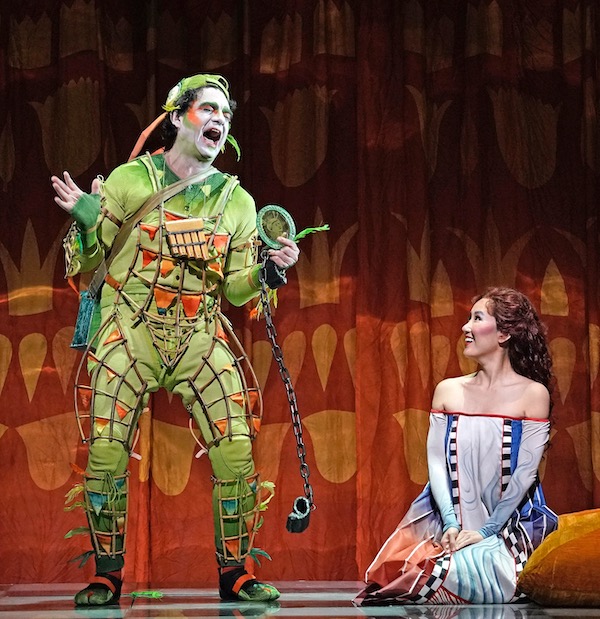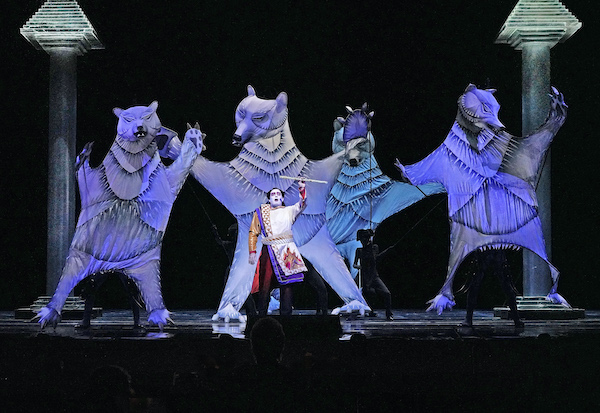Villazón returns and large bears delight in Met’s “Magic Flute”

December holidays are here, and that means the Metropolitan Opera’s Magic Flute is back, abridged and sung in English for the convenience of young and old, in Julie Taymor’s immensely (in every sense of the word) imaginative production.
The show opened its current run last Saturday night, and at Tuesday’s deuxième the solid cast and smooth orchestra under Jane Glover’s direction were in the groove. But one couldn’t help thinking maybe The Magic Bears would be a better title for this production, as Taymor’s looming puppet figures dominated the action with their enormous wingspan and lifelike motions.
Still, opera is spectacle, and one trusts that viewers who are new to the art will come for the dragon and the bird and giant living statues—Don Giovanni producers take note—and stay for Mozart’s exquisite music.
The abridged version preserves a fair chunk of the opera despite having been edited to move the complicated plot along faster.
Tenor Matthew Polenzani was the picture of infatuation in Tamino’s aria to Pamina’s portrait, and soprano Hera Hyesang Park stopped the show with the pathos of Pamina’s aria d’affetto after being “spurned” by Tamino (who had taken a vow of silence). That’s opera, too.
So are vocal gymnastics, and Kathryn Lewek’s astonishingly accurate staccato leaps as Queen of the Night remained reliable. She tended to strike a static pose while executing them, which didn’t do anything for the emotional dynamic of the scenes with Tamino and Pamina, but a skill like that deserved the ovation it received Tuesday night.
Stoicism, on the other hand, is not very operatic, and Tamino is required to show a lot of it in the face of Papageno’s clowning and Sarastro’s trials. The sturdy-voiced Polenzani made the most of his rare emotional moments in this abridged version.
Tamino can also help the comedy along as a straight man to Papageno’s antics. Although Polenzani and Rolando Villazón didn’t strike many sparks that way, the latter—returning to the Met stage after an eight-year absence due to vocal problems–proved an artful verbal and physical comic on his own as Papageno.
As a tenor making a comeback in a baritone role, Villazón relied on his acting ability Tuesday while singing clearly and comfortably enough in a lower range. He was charming in scenes with the petite, bright-toned Ashley Emerson as old-crone-turned-cutie Papagena.
Apart from Lewek’s dazzling Queen, the vocal standout of the evening was Park as a most sympathetic Pamina, her tender phrases rising to fill the house without apparent effort.
In this plot-centered version, the Queen’s villainous majordomo Monostatos seemed to turn up every few seconds with more lustful scheming. Preserving the production’s GP rating, tenor Rodell Rosel came across as more comical than threatening to Pamina’s honor, in a vocally and physically agile performance.e
Although bass Morris Robinson wasn’t quite as big as the bears, he brought an imposing physical presence to the role of Sarastro, and sang with great clarity and dignity.
Though brief, the role of Speaker addressing Tamino outside the temple requires a commanding voice, and bass-baritone Patrick Carfizzi delivered Tuesday night.
Singers Felicia Moore, Sarah Larsen, and Daryl Freedman overcame full-face masks and jet-black makeup to sing charmingly in the first and later scenes as First, Second, and Third Lady.
Three boy singers—Julian Knopf, Julian Fertel, and N. Casey Schopflocher—emitted soft, angelic and well-tuned tones as the guiding Spirits.
And let us not leave the cast without noting an unexpected Met debut, Matthew Burns stepping in as First Priest and hitting all his marks in a speaking role.
J.D. McClatchy’s just-colloquial-enough English translation was as intelligible as could be hoped for, thanks to the efforts of English coach Kathryn LaBouff. (With so much happening onstage, one didn’t want to spend the whole night reading seat-back subtitles.)
The Met Chorus and Children’s Chorus, prepared by Donald Palumbo and Anthony Piccolo respectively, proved essential both in tenebrous scenes and brilliant spectacle.
Mark Dendy’s fanciful choreography, featuring Maria Phegan as a high-stepping bird ballerina, kept the fairy-tale fantasy bubbling.
When not designing eye-catching puppets with Michael Curry, Taymor was dreaming up costumes ranging from a bird outfit for Papageno that looked back to Schikaneder’s 1791 original to futuristic geometrical vestments for Sarastro and his followers.
George Tsypin’s enormous rotating set, equal parts Star Wars and Aida, flashed with lightning and other effects by lighting designer Donald Holder and projections by Caterina Bertolotto.
As befitting her established Mozartean street-cred, conductor Glover provided lively and sympathetic musical direction, drawing out graceful phrasing and moving this plotty production along. The woodwinds went out of sync now and then, and might have held back a bit more to let Chelsea Knox’s rich-toned flute solos soar, but these were small complaints about a polished evening of music. Add to that 20-foot-tall dancing bears, and you’ve got something.
The Magic Flute runs though January 5. metopera.org;212-362-6000.






